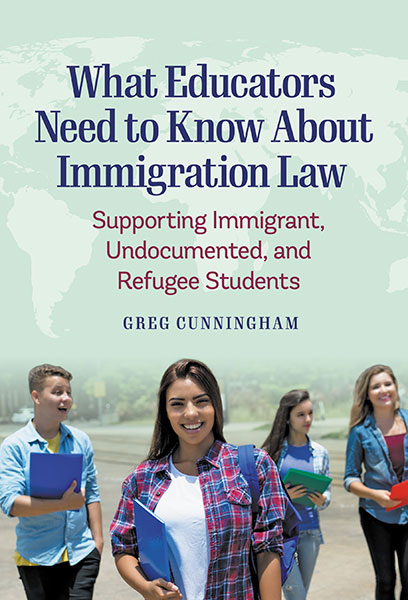Professors: Request an Exam Copy
Print copies available for US orders only. For orders outside the US, see our international distributors.
Publication Date: August 6, 2021
Pages: 128

Millions of students of noncitizen status or with undocumented family members experience financial, cultural, and socioemotional hardships that can result in profoundly adverse effects upon their academic performances and emotional well-being. In turn, teachers, counselors, and school leaders have deep concerns about the impact of immigration law on their students’ lives both within and outside of school. This book answers many questions that educators have asked of the author, who is a former teacher and legal advocate for ELL families, including the differences among immigrant, refugee, green card, and undocumented students; the right of a school to deny immigration officers entry to the building; and the ways that teachers and school leaders can connect families to services that could improve their students’ lives. The author also clears up misconceptions and provides useful information on the specific challenges, dangers, and benefits of each noncitizen category and their impacts on students. He notes protections provided by law, even for the undocumented, with classroom scenarios that bring student issues to life. This essential resource clarifies the law in plain, accessible language with practical suggestions on agencies and resources that schools can access, or direct families to, for advocacy and other supports. It is truly a resource that belongs in every school.
Book Features:
Greg Cunningham, a former middle school teacher with a master’s degree in Teaching English to Speakers of Other Languages (TESOL), is a conference speaker and frequent guest speaker in schools of education and other educational organizations. He is a senior paralegal with the immigration law firm of Quiroga Law Office, PLLC, in Washington State.
“Written by Greg Cunningham, a former middle school teacher who holds a master’s degree in TESOL (Teaching English to Speakers of Other Languages) and currently works in immigration law, the book can help educators at all levels better understand the complex topic of immigration law in our country.”
—NASSP Principal Leadership
“As the anti-immigrant climate persists regardless of leadership changes in the United States, in the book What Educators Need to Know About Immigration Law: Supporting Immigrant, Undocumented, and Refugee Students, Greg Cunningham provides an important introduction to the aspects of immigration law that are applicable to the work of K-12 educators.”
—Teachers College Record
“A compelling and critical resource for inservice and preservice educators, para-educators, administrators, and advocates. Greg Cunningham offers accessible navigation, charting the intersection of education, immigration, and law through the equity lens.”
—Joshua Porter, chair, Spokane Regional ESOL Consortium
Contents
Introduction 1
PART I: IMMIGRATION STATUS AS A LEGAL CONSTRUCT 7
1. Citizenship and Lawful Permanent Residence 13
Three Paths to Citizenship 13
Lawful Permanent Residence 15
Conclusion and Teacher Takeaway: A Clearer Understanding of Citizenship and Lawful Permanent Residence 18
2. Non-Permanent Status 19
Lawful Nonimmigrants 20
Refugees and Asylees 23
Undocumented Immigrants 31
Deferred Action for Childhood Arrivals (DACA) 35
Temporary Protected Status (TPS) 39
A Note on Jurisdiction 40
Compact of Free Association 40
Seeking Legal Advice 41
Conclusion and Teacher Takeaway: The Value of Understanding Status 42
Part I Epilogue: Scenarios Revisited 44
PART II: STATUS AND LIMITS 45
3. Limits on Activity 47
Participation in the Public Square 47
Movement Within and In and Out of the United States 47
4. Benefits and Their Limitations 49
Federal Benefits 50
State Benefits 52
Benefits for School-Age Children 52
Student Financial Aid 53
5. The Immigration Consequences of Noncitizens’ Criminal Activity 56
Crimes That Can Lead to Removal 56
Conclusion and Teacher Takeaway: The Value of Understanding Limits to Status 58
Part II Epilogue: Scenarios Revisited 59
PART III: NONCITIZENS AND CIVIL RIGHTS 61
6. The Powers of Immigration Officers 63
Extending the Reach of DHS 64
7. Know Your Rights 68
Individual Rights 68
ICE and Schools 69
Conclusion and Teacher Takeaway: The Value of Understanding Noncitizens and Civil Rights 69
Part III Epilogue: Scenario Revisited 70
PART IV: HOW WE GOT HERE 71
8. Immigration Law and Plenary Power 73
The Supreme Court and Clarification of Jurisdiction over Immigration Law 74
9. The Hart-Celler Act and the Rise of Anti-Immigrant Sentiment in the 21st Century 78
Enhanced Border Security Under Trump 80
Enhanced Interior Enforcement Under Trump 81
Conclusion and Teacher Takeaway: Anti-Immigrant Feelings and a Growing Immigrant Population 84
PART V: RESOURCES AND ADVOCACY 87
10. Agencies and Organizations 89
Get to Know Your Refugee Resettlement Agencies 89
After Resettlement 90
Public Assistance 91
Student Financial Aid 91
Mutual Assistance Associations 92
Immigration Services 92
Domestic Violence Services 93
Local Law Enforcement 93
Other Services 94
Conclusion 95
References 97
Index 111
About the Author 120
Professors: Request an Exam Copy
Print copies available for US orders only. For orders outside the US, see our international distributors.